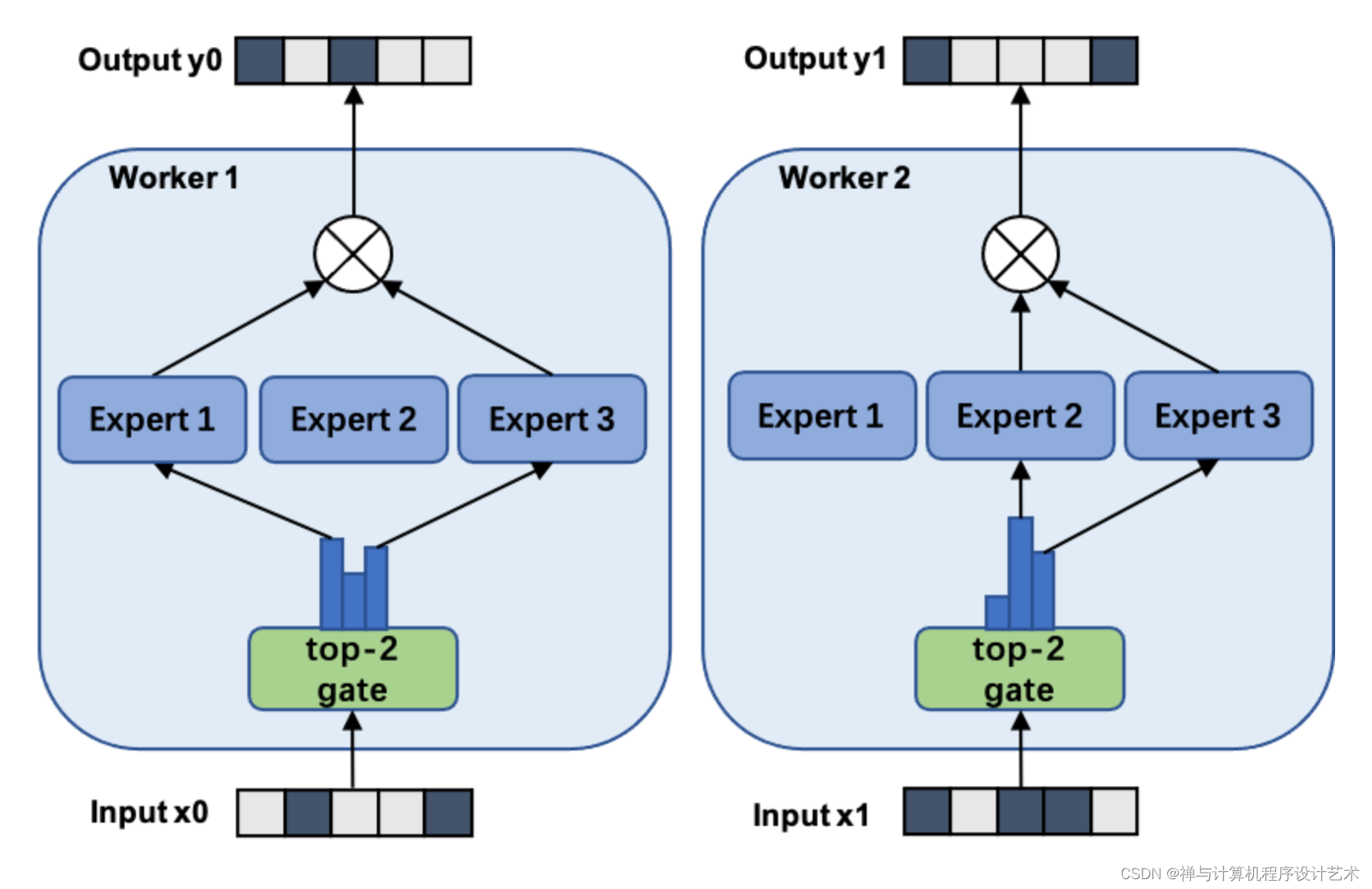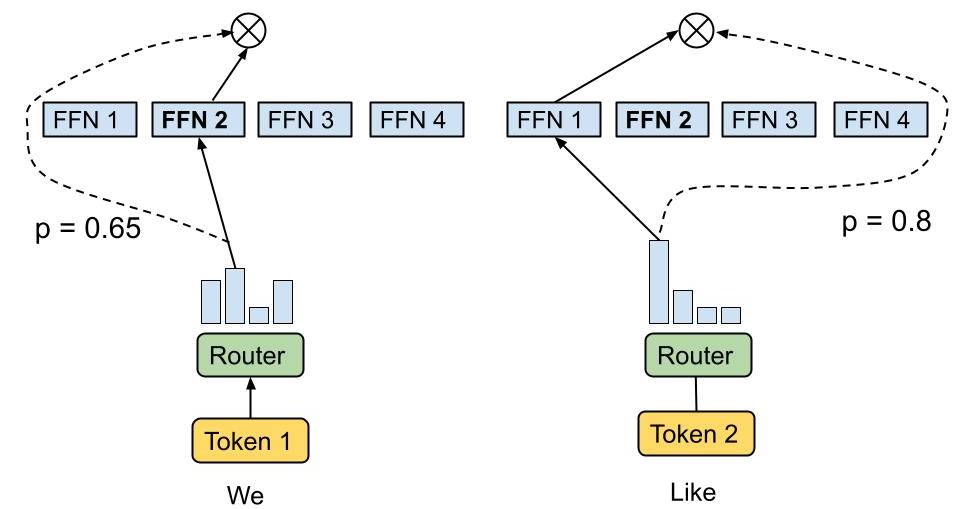门控融合网络 (GFN) 和混合专家 (MoE)
门控融合网络 (GFN) 和混合专家 (MoE) 都是神经网络中使用的架构,特别是用于处理需要组合来自多个来源或模型的信息的复杂数据和任务。以下是每项的概述:
1. Gated Fusion Network (GFN):门控融合网络(GFN):
GFN 旨在通过学习门控机制来融合或合并来自不同模式或来源的信息。它由多个数据处理流组成,每个数据处理流都专注于特定方面或信息源。
门控机制控制每个流对最终预测或输出贡献的权重。
通过学习这些门函数,GFN 可以有效地结合不同的信息源。
门控融合网络旨在通过学习控制信息集成方式的门控机制来融合来自多个来源的信息。它包含处理不同类型数据的各种路径,门控机制决定每个路径对最终输出贡献多少权重。这种门控机制允许网络动态地强调或弱化特定信息源,从而实现更好的表示学习并捕获输入之间的复杂依赖关系。
1.1 代码举例
import torch
import torch.nn as nn
class GatedFusionNetwork(nn.Module):
def __init__(self, input_size1, input_size2, hidden_size):
super(GatedFusionNetwork, self).__init__()
self.pathway1 = nn.Linear(input_size1, hidden_size)
self.pathway2 = nn.Linear(input_size2, hidden_size)
self.gating = nn.Sequential(
nn.Linear(hidden_size * 2, hidden_size),
nn.Sigmoid()
)
self.output = nn.Linear(hidden_size, 1)
def forward(self, input1, input2):
out1 = torch.relu(self.pathway1(input1))
out2 = torch.relu(self.pathway2(input2))
fused = torch.cat((out1, out2), dim=1)
gate = self.gating(fused)
gated_output = gate * out1 + (1 - gate) * out2
output = self.output(gated_output)
return output
# Example Usage:
input_data1 = torch.randn(1, 10) # Fake input 1
input_data2 = torch.randn(1, 5) # Fake input 2
model = GatedFusionNetwork(10, 5, 20)
output = model(input_data1, input_data2)
print(output.item()) # Fake output
2. Mixture of Experts (MoE) Expert Network:专家混合 (MoE) 专家网络:
专家混合模型涉及多个称为专家的子网络,它们专门研究输入空间的不同部分。它由一个门控网络组成,用于确定哪个专家或专家组合最适合处理特定输入。每个专家都专注于数据的特定区域或方面,门控机制决定如何组合他们的输出以产生最终输出。
MoE 是一种神经网络架构,涉及多个协同工作的“专家”子网络(较小的神经网络),每个子网络专门研究输入空间的一个子集。这些专家做出单独的预测,门控网络决定每个专家的输出对最终预测的贡献程度。 MoE 可以通过允许不同的专家专门研究数据的不同区域或方面来处理数据中的复杂模式。
2.1 代码举例
class Expert(nn.Module):
def __init__(self, input_size, hidden_size):
super(Expert, self).__init__()
self.fc = nn.Linear(input_size, hidden_size)
self.output = nn.Linear(hidden_size, 1)
def forward(self, x):
out = torch.relu(self.fc(x))
return self.output(out)
class MixtureOfExperts(nn.Module):
def __init__(self, num_experts, input_size, hidden_size):
super(MixtureOfExperts, self).__init__()
self.experts = nn.ModuleList([Expert(input_size, hidden_size) for _ in range(num_experts)])
self.gating = nn.Sequential(
nn.Linear(input_size, num_experts),
nn.Softmax(dim=1)
)
def forward(self, x):
gates = self.gating(x)
expert_outs = [expert(x) for expert in self.experts]
weighted_outs = [gate * expert_out for gate, expert_out in zip(gates.unbind(1), expert_outs)]
output = torch.stack(weighted_outs, dim=2).sum(dim=2)
return output.squeeze()
# Example Usage:
input_data = torch.randn(1, 10) # Fake input
model = MixtureOfExperts(3, 10, 20)
output = model(input_data)
print(output.item()) # Fake output
2.2 gpt 中的相关

混合专家模型(Mixture of Experts, MoE)是一种用于解决大规模数据集上的复杂任务的神经网络模型。它可以自适应地组合多个专家网络来处理不同的数据子集,从而提高模型的泛化能力和性能。本文将对MoE模型的原理进行讲解,包括其数学公式和代码实现。
专家混合 (MoE) 是 LLM 中常用的一种技术,旨在提高其效率和准确性。这种方法的工作原理是将复杂的任务划分为更小、更易于管理的子任务,每个子任务都由专门的迷你模型或「专家」处理。
具体来说,「专家层」是较小的神经网络,经过训练在特定领域具有高技能,每个专家处理相同的输入,但处理方式与其特定的专业相一致;「门控网络」是 MoE 架构的决策者,能评估哪位专家最适合给定的输入数据。网络计算输入与每个专家之间的兼容性分数,然后使用这些分数来确定每个专家在任务中的参与程度。
我们都知道,OpenAI 团队一直对 GPT-4 的参数量和训练细节守口如瓶。早些时候,有人爆料 GPT-4 是采用了由 8 个专家模型组成的集成系统。后来又有传闻称,ChatGPT 也只是百亿参数级的模型(大概在 200 亿左右)。
传闻无从证明,但 Mistral 8x7B 可能提供了一种「非常接近 GPT-4」的开源选项。从模型元数据中可以看出,对于每个 token 的推理,Mistral 8x7B 仅使用 2 个专家。
MoE模型原理
2.1.1 基本结构
MoE模型由两部分组成:门控网络和专家网络。门控网络用于选择哪个专家网络处理输入数据,而每个专家网络负责处理相应的数据子集。
下图展示了一个有三个专家的两路数据并行MoE模型进行前向计算的方式.

下图展示了一个有六个专家网络的模型被两路模型并行地训练.
注意专家1-3被放置在第一个计算单元上, 而专家4-6被放置在第二个计算单元上.

2.1.2 门控网络
门控网络用于选择哪个专家网络处理输入数据。它的输出结果是一个概率向量,表示每个专家网络被选择的概率。MoE模型中常用的门控网络是Softmax门控网络和Gating Tree门控网络。
2.1.3 Softmax门控网络
Softmax门控网络是一种基于Softmax函数的门控网络。它将输入数
大纲
- Mixture-of-Experts (MoE)
- Mixture of Sequential Experts(MoSE)
- Multi-gate Mixture-of-Experts (MMoE)
一、MoE
1. MoE架构
MoE(Mixture of Experts)层包含一个门网络(Gating Network)和n个专家网络(Expert Network)。对于每一个输入,动态地由门网络选择k个专家网络进行激活。在具体设计中,每个输入x激活的专家网络数量k往往是一个非常小的数字。比如在MoE论文的一些实验中,作者采用了n=512,k=2的设定,也就是每次只会从512个专家网络中挑选两个来激活。在模型运算量(FLOPs)基本不变的情况下,可以显著增加模型的参数量。
MoE架构的主要特点是在模型中引入了专家网络层,通过路由机制(Routing function)选择激活哪些专家,以允许不同的专家模型对输入进行独立处理,并通过加权组合它们的输出来生成最终的预测结果。

通过稀疏模型MoE扩大大语言模型的方法:以GLaM模型为例,它包含1.2T个参数,但实际上被激活的参数(activated parameters)只有97B,远少于GPT-3,也就是说,它是稀疏激活的MoE。它与GPT-3同样是只有解码器的模型,但与GPT-3相比,GlaM获得了更好的性能。
稀疏模型的优势在于它能够更有效地利用模型参数,减少不必要的计算开销,从而提高模型的性能。
- 可以扩大模型的参数数量,因为只需要激活部分参数,其他参数可以被"关机"。这降低了计算量和内存消耗。
- 提高效率:只激活相关的专家模块,可以提高模型效率。
- 组合优势:通过组合不同专家的优势,有可能获得更好的效果。
混合专家系统有两种架构:competitive MoE 和cooperative MoE。competitive MoE中数据的局部区域被强制集中在数据的各离散空间,而cooperative MoE没有进行强制限制。
2. GateNet:决策输入样本由哪个专家处理
GateNet可以理解为一个分配器,根据输入样本的特征,动态决策将其分配给哪个专家进行处理。这个过程可以通过一个softmax分类器来实现,其中每个神经元对应一个专家模型。GateNet的输出值表示了每个专家的权重。 GateNet的设计需要考虑两个关键点:输入样本特征的提取和分配策略的确定。在特征的提取方面,常用的方法是使用卷积神经网络(CNN)或者Transformer等结构来提取输入样本的特征表示。而在分配策略的确定方面,可以采用不同的注意力机制或者引入一些先验知识来指导。
这种训练过程传统上是使用期望最大化 (Expectation Maximization, EM) 来实现的。门控网络可能有一个 softmax 输出,它为每个专家提供类似概率的置信度分数。

对softmax做了一些改动。第一个变动就是KeepTopK,这是个离散函数,将top-k之外的值强制设为负无穷大,从而softmax后的值为0。第二个变动是加了noise,这个的目的是为了做均衡,这里引入了一个Wnoise的参数,后面还会在损失函数层面进行改动。
上述公式表示了包含 n 个专家的 MoE 层的计算过程。具体来讲,首先对样本 x 进行门控计算, W 表示权重矩阵;然后由 Softmax 处理后获得样本 x 被分配到各个 expert 的权重; 然后只取前 k (通常取 1 或者 2)个最大权重,最终整个 MoE Layer 的计算结果就是选中的 k 个专家网络输出的加权和。
3Experts:专家模型的构建与训练
专家模型是MoE架构中的核心组件,它们负责处理输入样本的具体任务。每个专家模型都是相对独立的,可以根据任务的需求选择不同的模型架构。 在训练阶段,专家模型可以采用传统的有监督学习方法进行训练。然而,为了提高模型的效果,还可以引入一些主从式训练策略。即通过联合训练GateNet和Experts,共同优化整个MoE架构。
为了改进只有几个expert会被集中使用这一问题,给每个expert定义了一个importance的概念。importance就是指这个expert所处理的样本数,简而言之就是G(x)对应位置的和。损失函数则是importance的平方乘以一个系数。

4. 代码实现
# Sparsely-Gated Mixture-of-Experts Layers.
# See "Outrageously Large Neural Networks"
# https://arxiv.org/abs/1701.06538
#
# Author: David Rau
#
# The code is based on the TensorFlow implementation:
# https://github.com/tensorflow/tensor2tensor/blob/master/tensor2tensor/utils/expert_utils.py
import torch
import torch.nn as nn
from torch.distributions.normal import Normal
import numpy as np
class SparseDispatcher(object):
"""Helper for implementing a mixture of experts.
The purpose of this class is to create input minibatches for the
experts and to combine the results of the experts to form a unified
output tensor.
There are two functions:
dispatch - take an input Tensor and create input Tensors for each expert.
combine - take output Tensors from each expert and form a combined output
Tensor. Outputs from different experts for the same batch element are
summed together, weighted by the provided "gates".
The class is initialized with a "gates" Tensor, which specifies which
batch elements go to which experts, and the weights to use when combining
the outputs. Batch element b is sent to expert e iff gates[b, e] != 0.
The inputs and outputs are all two-dimensional [batch, depth].
Caller is responsible for collapsing additional dimensions prior to
calling this class and reshaping the output to the original shape.
See common_layers.reshape_like().
Example use:
gates: a float32 `Tensor` with shape `[batch_size, num_experts]`
inputs: a float32 `Tensor` with shape `[batch_size, input_size]`
experts: a list of length `num_experts` containing sub-networks.
dispatcher = SparseDispatcher(num_experts, gates)
expert_inputs = dispatcher.dispatch(inputs)
expert_outputs = [experts[i](expert_inputs[i]) for i in range(num_experts)]
outputs = dispatcher.combine(expert_outputs)
The preceding code sets the output for a particular example b to:
output[b] = Sum_i(gates[b, i] * experts[i](inputs[b]))
This class takes advantage of sparsity in the gate matrix by including in the
`Tensor`s for expert i only the batch elements for which `gates[b, i] > 0`.
"""
def __init__(self, num_experts, gates):
"""Create a SparseDispatcher."""
self._gates = gates
self._num_experts = num_experts
# sort experts
sorted_experts, index_sorted_experts = torch.nonzero(gates).sort(0)
# drop indices
_, self._expert_index = sorted_experts.split(1, dim=1)
# get according batch index for each expert
self._batch_index = torch.nonzero(gates)[index_sorted_experts[:, 1], 0]
# calculate num samples that each expert gets
self._part_sizes = (gates > 0).sum(0).tolist()
# expand gates to match with self._batch_index
gates_exp = gates[self._batch_index.flatten()]
self._nonzero_gates = torch.gather(gates_exp, 1, self._expert_index)
def dispatch(self, inp):
"""Create one input Tensor for each expert.
The `Tensor` for a expert `i` contains the slices of `inp` corresponding
to the batch elements `b` where `gates[b, i] > 0`.
Args:
inp: a `Tensor` of shape "[batch_size, <extra_input_dims>]`
Returns:
a list of `num_experts` `Tensor`s with shapes
`[expert_batch_size_i, <extra_input_dims>]`.
"""
# assigns samples to experts whose gate is nonzero
# expand according to batch index so we can just split by _part_sizes
inp_exp = inp[self._batch_index].squeeze(1)
return torch.split(inp_exp, self._part_sizes, dim=0)
def combine(self, expert_out, multiply_by_gates=True):
"""Sum together the expert output, weighted by the gates.
The slice corresponding to a particular batch element `b` is computed
as the sum over all experts `i` of the expert output, weighted by the
corresponding gate values. If `multiply_by_gates` is set to False, the
gate values are ignored.
Args:
expert_out: a list of `num_experts` `Tensor`s, each with shape
`[expert_batch_size_i, <extra_output_dims>]`.
multiply_by_gates: a boolean
Returns:
a `Tensor` with shape `[batch_size, <extra_output_dims>]`.
"""
# apply exp to expert outputs, so we are not longer in log space
stitched = torch.cat(expert_out, 0).exp()
if multiply_by_gates:
stitched = stitched.mul(self._nonzero_gates)
zeros = torch.zeros(self._gates.size(0), expert_out[-1].size(1), requires_grad=True, device=stitched.device)
# combine samples that have been processed by the same k experts
combined = zeros.index_add(0, self._batch_index, stitched.float())
# add eps to all zero values in order to avoid nans when going back to log space
combined[combined == 0] = np.finfo(float).eps
# back to log space
return combined.log()
def expert_to_gates(self):
"""Gate values corresponding to the examples in the per-expert `Tensor`s.
Returns:
a list of `num_experts` one-dimensional `Tensor`s with type `tf.float32`
and shapes `[expert_batch_size_i]`
"""
# split nonzero gates for each expert
return torch.split(self._nonzero_gates, self._part_sizes, dim=0)
class MLP(nn.Module):
def __init__(self, input_size, output_size, hidden_size):
super(MLP, self).__init__()
self.fc1 = nn.Linear(input_size, hidden_size)
self.fc2 = nn.Linear(hidden_size, output_size)
self.relu = nn.ReLU()
self.soft = nn.Softmax(1)
def forward(self, x):
out = self.fc1(x)
out = self.relu(out)
out = self.fc2(out)
out = self.soft(out)
return out
class MoE(nn.Module):
"""Call a Sparsely gated mixture of experts layer with 1-layer Feed-Forward networks as experts.
Args:
input_size: integer - size of the input
output_size: integer - size of the input
num_experts: an integer - number of experts
hidden_size: an integer - hidden size of the experts
noisy_gating: a boolean
k: an integer - how many experts to use for each batch element
"""
def __init__(self, input_size, output_size, num_experts, hidden_size, noisy_gating=True, k=4):
super(MoE, self).__init__()
self.noisy_gating = noisy_gating
self.num_experts = num_experts
self.output_size = output_size
self.input_size = input_size
self.hidden_size = hidden_size
self.k = k
# instantiate experts
self.experts = nn.ModuleList([MLP(self.input_size, self.output_size, self.hidden_size) for i in range(self.num_experts)])
self.w_gate = nn.Parameter(torch.zeros(input_size, num_experts), requires_grad=True)
self.w_noise = nn.Parameter(torch.zeros(input_size, num_experts), requires_grad=True)
self.softplus = nn.Softplus()
self.softmax = nn.Softmax(1)
self.register_buffer("mean", torch.tensor([0.0]))
self.register_buffer("std", torch.tensor([1.0]))
assert(self.k <= self.num_experts)
def cv_squared(self, x):
"""The squared coefficient of variation of a sample.
Useful as a loss to encourage a positive distribution to be more uniform.
Epsilons added for numerical stability.
Returns 0 for an empty Tensor.
Args:
x: a `Tensor`.
Returns:
a `Scalar`.
"""
eps = 1e-10
# if only num_experts = 1
if x.shape[0] == 1:
return torch.tensor([0], device=x.device, dtype=x.dtype)
return x.float().var() / (x.float().mean()**2 + eps)
def _gates_to_load(self, gates):
"""Compute the true load per expert, given the gates.
The load is the number of examples for which the corresponding gate is >0.
Args:
gates: a `Tensor` of shape [batch_size, n]
Returns:
a float32 `Tensor` of shape [n]
"""
return (gates > 0).sum(0)
def _prob_in_top_k(self, clean_values, noisy_values, noise_stddev, noisy_top_values):
"""Helper function to NoisyTopKGating.
Computes the probability that value is in top k, given different random noise.
This gives us a way of backpropagating from a loss that balances the number
of times each expert is in the top k experts per example.
In the case of no noise, pass in None for noise_stddev, and the result will
not be differentiable.
Args:
clean_values: a `Tensor` of shape [batch, n].
noisy_values: a `Tensor` of shape [batch, n]. Equal to clean values plus
normally distributed noise with standard deviation noise_stddev.
noise_stddev: a `Tensor` of shape [batch, n], or None
noisy_top_values: a `Tensor` of shape [batch, m].
"values" Output of tf.top_k(noisy_top_values, m). m >= k+1
Returns:
a `Tensor` of shape [batch, n].
"""
batch = clean_values.size(0)
m = noisy_top_values.size(1)
top_values_flat = noisy_top_values.flatten()
threshold_positions_if_in = torch.arange(batch, device=clean_values.device) * m + self.k
threshold_if_in = torch.unsqueeze(torch.gather(top_values_flat, 0, threshold_positions_if_in), 1)
is_in = torch.gt(noisy_values, threshold_if_in)
threshold_positions_if_out = threshold_positions_if_in - 1
threshold_if_out = torch.unsqueeze(torch.gather(top_values_flat, 0, threshold_positions_if_out), 1)
# is each value currently in the top k.
normal = Normal(self.mean, self.std)
prob_if_in = normal.cdf((clean_values - threshold_if_in)/noise_stddev)
prob_if_out = normal.cdf((clean_values - threshold_if_out)/noise_stddev)
prob = torch.where(is_in, prob_if_in, prob_if_out)
return prob
def noisy_top_k_gating(self, x, train, noise_epsilon=1e-2):
"""Noisy top-k gating.
See paper: https://arxiv.org/abs/1701.06538.
Args:
x: input Tensor with shape [batch_size, input_size]
train: a boolean - we only add noise at training time.
noise_epsilon: a float
Returns:
gates: a Tensor with shape [batch_size, num_experts]
load: a Tensor with shape [num_experts]
"""
clean_logits = x @ self.w_gate
if self.noisy_gating and train:
raw_noise_stddev = x @ self.w_noise
noise_stddev = ((self.softplus(raw_noise_stddev) + noise_epsilon))
noisy_logits = clean_logits + (torch.randn_like(clean_logits) * noise_stddev)
logits = noisy_logits
else:
logits = clean_logits
# calculate topk + 1 that will be needed for the noisy gates
top_logits, top_indices = logits.topk(min(self.k + 1, self.num_experts), dim=1)
top_k_logits = top_logits[:, :self.k]
top_k_indices = top_indices[:, :self.k]
top_k_gates = self.softmax(top_k_logits)
zeros = torch.zeros_like(logits, requires_grad=True)
gates = zeros.scatter(1, top_k_indices, top_k_gates)
if self.noisy_gating and self.k < self.num_experts and train:
load = (self._prob_in_top_k(clean_logits, noisy_logits, noise_stddev, top_logits)).sum(0)
else:
load = self._gates_to_load(gates)
return gates, load
def forward(self, x, loss_coef=1e-2):
"""Args:
x: tensor shape [batch_size, input_size]
train: a boolean scalar.
loss_coef: a scalar - multiplier on load-balancing losses
Returns:
y: a tensor with shape [batch_size, output_size].
extra_training_loss: a scalar. This should be added into the overall
training loss of the model. The backpropagation of this loss
encourages all experts to be approximately equally used across a batch.
"""
gates, load = self.noisy_top_k_gating(x, self.training)
# calculate importance loss
importance = gates.sum(0)
#
loss = self.cv_squared(importance) + self.cv_squared(load)
loss *= loss_coef
dispatcher = SparseDispatcher(self.num_experts, gates)
expert_inputs = dispatcher.dispatch(x)
gates = dispatcher.expert_to_gates()
expert_outputs = [self.experts[i](expert_inputs[i]) for i in range(self.num_experts)]
y = dispatcher.combine(expert_outputs)
return y, loss
https://github.com/davidmrau/mixture-of-experts
MoSE

References
3. 差异和联系:
-
GFN 专注于使用门控机制融合来自不同来源或模式的信息,门控机制:GFN 主要关注集成信息的门控机制;而 MoE 使用门控将输入路由到不同的专家, MoE 专注于创建一个专家网络,共同为最终预测做出贡献。
-
MoE 明确使用多个专门的子网络(专家),而 GFN 经常集成来自不同路径的信息,而没有明确的专门模块。
-
架构差异:GFN 将多个数据流与门控机制相结合,而 MoE 由多个专家网络组成,并通过门控机制来衡量其贡献。
-
信息处理:GFN强调多源信息的动态融合,而MoE则注重专家的专门处理。
Application: Both architectures aim to handle complex information integration but may be suited to different types of problems or data structures. GFN may be more versatile when integrating diverse information sources, while MoE might excel when the problem benefits from specialized experts.
reference
https://blog.csdn.net/m0_64768308/article/details/133963803#t3
本文来自互联网用户投稿,该文观点仅代表作者本人,不代表本站立场。本站仅提供信息存储空间服务,不拥有所有权,不承担相关法律责任。 如若内容造成侵权/违法违规/事实不符,请联系我的编程经验分享网邮箱:chenni525@qq.com进行投诉反馈,一经查实,立即删除!
- Python教程
- 深入理解 MySQL 中的 HAVING 关键字和聚合函数
- Qt之QChar编码(1)
- MyBatis入门基础篇
- 用Python脚本实现FFmpeg批量转换
- Rust:qmetaobject 框架的环境变量和搜索路径设置
- 基于springboot+微信小程序实现零担物流智慧管理平台【附项目源码+论文说明】
- 电脑提示找不到vcruntime140.dll,无法继续执行代码的解决办法
- 【Mysql basic commands/query: how to update the message/record data of each row】
- Python列表数据处理全攻略(六):常用内置方法轻松掌握
- FL Studio 21.2.2官方中文版重磅发布
- 【MySQL】MySQL表的操作-创建查看删除和修改
- pinia访问其他store的action报错:未初始化调用getActivePinia()
- 计算机毕业设计 基于SSM的果蔬作物疾病防治系统的设计与实现 Java实战项目 附源码+文档+视频讲解
- C#基础环境搭建